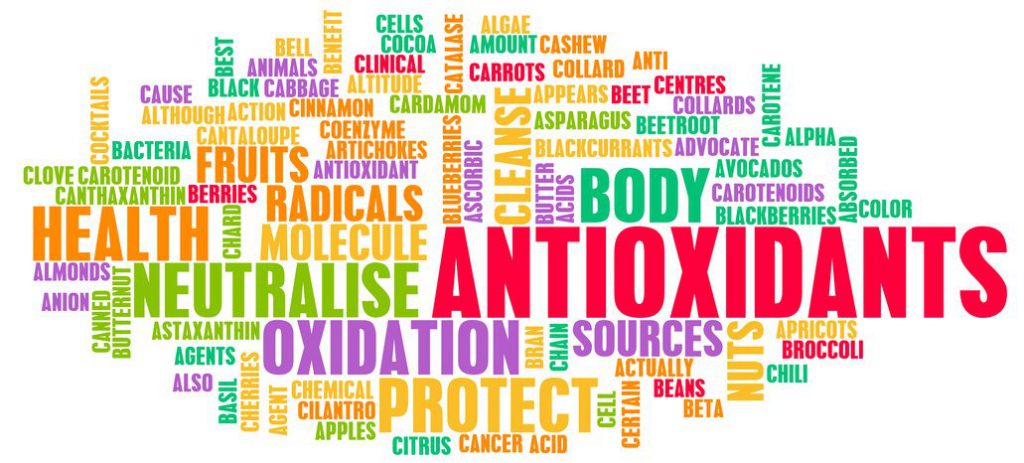Why are antioxidants so much-talked-about? They are likely to be the most important substances in your whole body. They are synthetic or natural and their main task is – as the name suggests – fighting the oxidants which are also known as free radicals damaging body cells, speeding up aging processes and causing serious (e.g. cancerous) diseases. Do you know what free radicals are and how antioxidants affect your body? Let’s take a tour around your body to see good and bad changes taking place all the time. You should know how and what to use to reduce the harmfulness of the bad processes.
What are free radicals actually?
Before we can understand what antioxidants are, we must explain what hides behind the term ‘oxidants’.
We are familiar with oxidants, also called free radicals, because of commercials and beauty products’ descriptions. These tiny ubiquitous molecules occur naturally in the body during various metabolic processes e.g. while we breathe. This is the only fair side of the oxidants.
Recently, we can hear about ROS, or reactive oxygen supplies – free radicals quite often. They are atoms, ions and molecules which contain at least one unpaired electron. They are exceptionally reactive, or aggressive – they try to attract the missing electron by attacking and damaging body cells.
During the attack, free radicals aim at human proteins, unsaturated fatty acids in cell membrane and (sadly) our DNA. This is what makes reactive oxygen supplies the most common cause of cancers.
Still, the fact remains that some free radicals are necessary for the body to function: they work like military groups damaging pathogenic bacteria and removing toxic substances. They have a negative effect when there are too many of them. The excess of free radicals makes cells colonize our organism and attack healthy cells.
Too many reactive oxygen supplies may have various causes which can be summed up to unhealthy lifestyle – long-term exposure to air pollution, cigarette smoke, UV radiation, eating lots of processed food, taking medication. Free radicals are also produced in some foods such as sweets with long shelf life and fried food e.g. crisps and chips.
The technological development, environmental pollution and other elements make more and more free radicals surround and attack us. Their number increases due to:
- smoking cigarettes and drinking alcohol;
- X-rays;
- the sunlight and ozone hole;
- exposure to heavy metals (lead, cadmium, mercury), nitrogen oxide (food, fumes, pollution);
- eating products packed with trans fats;
- too intensive workout;
- medication (antidepressants, contraceptives, steroids, anticoagulants).
Did you know that every cell in the body of a twenty-year-old is exposed to around 100 000 attacks of free radicals? The warlike molecules in excess attack and destroy everything they come across.
What are antioxidants?
Antioxidants make up a group of chemicals for special tasks – they have the ability to neutralize ROS. They prevent the cellular damage. A free radical meets an antioxidant which gifts it with the missing electron. The antioxidant itself becomes a neutral molecule and is removed from the body.
Antioxidants can be divided into two groups:
- endogenous – enzymes which are present in our body cells e.g. glutathione (synthetized by vitamin C);
- exogenous – delivered with food or supplements.
What is oxidative stress?
If there is a balance between reactive oxygen supplies and antioxidants, there are no threats to our health and the body functions smoothly. When too many free radicals occur and antioxidants fail to deactivate (neutralize) them, we come up against the so-called oxidative stress.
It is a serious condition which increases the risk of suffering from many diseases, including sclerosis, blood hypertension, bronchial asthma, diabetes complications, diseases damaging the nervous system (Parkinson, Alzheimer), cancers, as well as less serious yet unwelcome intensified aging processes.
There are lots of antioxidant-rich foods and supplements. Obviously, if your body lacks enough antioxidants, the skin is the last in the line to receive them. That is why cosmetologists infuse creams with antioxidants. Used externally, they are extremely effective, which has been proven by many tests and studies.
Free radicals are quite sneaky and can be compared to UVA radiation: we cannot see or feel their destructive power immediately. During the attack, we don’t feel any discomfort or see much worse skin condition. Only after several years, we can spot the effect in the form of premature skin aging. Antioxidants – systemically delivered to the body – slow down the unwanted processes.
The most common antioxidants in cosmetics:
- vitamin C,
- vitamin E,
- coenzyme Q10,
- idebenone (coenzyme Q10 analog),
- ferulic acid,
- lipoic acid,
- polyphenol and flavonoid-rich extracts: soybean, green tea, grapeseed, milk thistle, citruses, rosemary, ginkgo extracts.



Leave a Reply